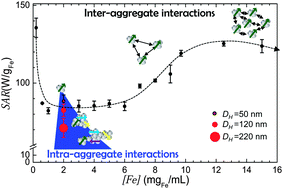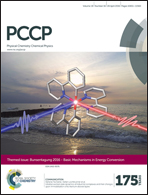Effects of inter- and intra-aggregate magnetic dipolar interactions on the magnetic heating efficiency of iron oxide nanoparticles†
Abstract
Iron oxide nanoparticles have found an increasing number of biomedical applications as sensing or trapping platforms and therapeutic and/or diagnostic agents. Most of these applications are based on their magnetic properties, which may vary depending on the nanoparticle aggregation state and/or concentration. In this work, we assess the effect of the inter- and intra-aggregate magnetic dipolar interactions on the heat dissipation power and AC hysteresis loops upon increasing the nanoparticle concentration and the hydrodynamic aggregate size. We observe different effects produced by inter- (long distance) and intra-aggregate (short distance) interactions, resulting in magnetizing and demagnetizing effects, respectively. Consequently, the heat dissipation power under alternating magnetic fields strongly reflects such different interacting phenomena. The intra-aggregate interaction results were successfully modeled by numerical simulations. A better understanding of magnetic dipolar interactions is mandatory for achieving a reliable magnetic hyperthermia response when nanoparticles are located into biological matrices.


 Please wait while we load your content...
Please wait while we load your content...